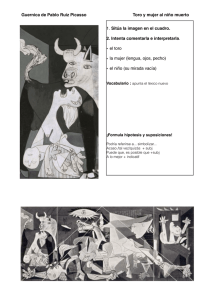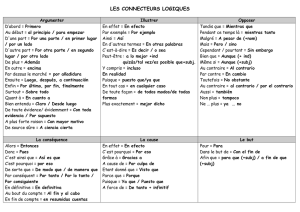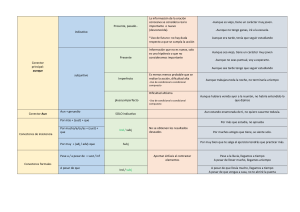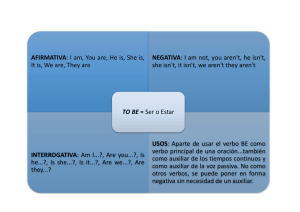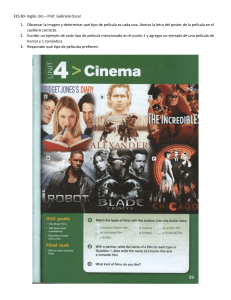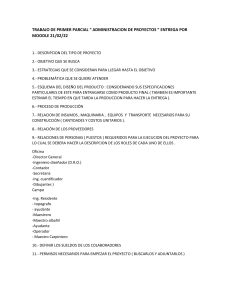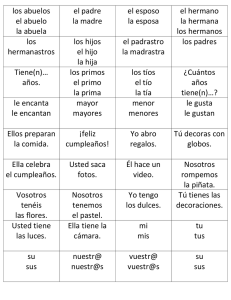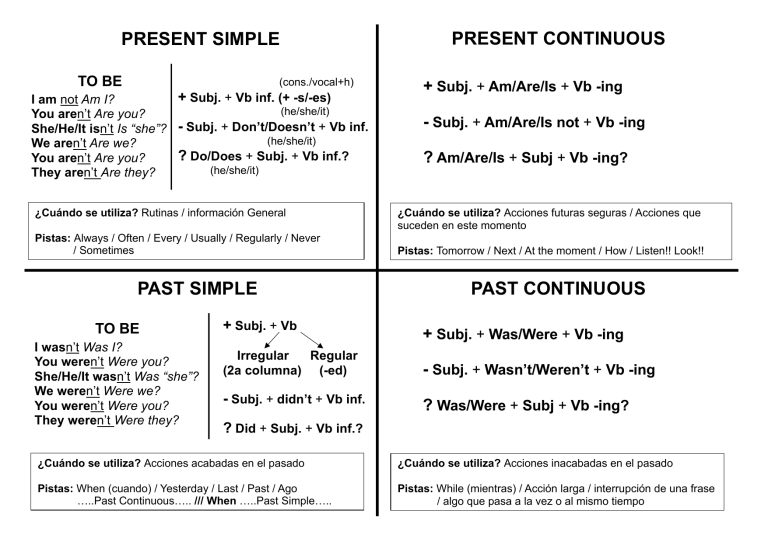
PRESENT SIMPLE TO BE (cons./vocal+h) + Subj. + Vb inf. (+ -s/-es) I am not Am I? (he/she/it) You aren’t Are you? She/He/It isn’t Is “she”? - Subj. + Don’t/Doesn’t + Vb inf. (he/she/it) We aren’t Are we? ? Do/Does + Subj. + Vb inf.? You aren’t Are you? (he/she/it) They aren’t Are they? ¿Cuándo se utiliza? Rutinas / información General Pistas: Always / Often / Every / Usually / Regularly / Never / Sometimes PAST SIMPLE TO BE I wasn’t Was I? You weren’t Were you? She/He/It wasn’t Was “she”? We weren’t Were we? You weren’t Were you? They weren’t Were they? + Subj. + Vb Irregular Regular (2a columna) (-ed) - Subj. + didn’t + Vb inf. PRESENT CONTINUOUS + Subj. + Am/Are/Is + Vb -ing - Subj. + Am/Are/Is not + Vb -ing ? Am/Are/Is + Subj + Vb -ing? ¿Cuándo se utiliza? Acciones futuras seguras / Acciones que suceden en este momento Pistas: Tomorrow / Next / At the moment / How / Listen!! Look!! PAST CONTINUOUS + Subj. + Was/Were + Vb -ing - Subj. + Wasn’t/Weren’t + Vb -ing ? Was/Were + Subj + Vb -ing? ? Did + Subj. + Vb inf.? ¿Cuándo se utiliza? Acciones acabadas en el pasado ¿Cuándo se utiliza? Acciones inacabadas en el pasado Pistas: When (cuando) / Yesterday / Last / Past / Ago …..Past Continuous….. /// When …..Past Simple….. Pistas: While (mientras) / Acción larga / interrupción de una frase / algo que pasa a la vez o al mismo tiempo PRESENT PERFECT SIMPLE PRESENT PERFECT CONTINUOUS + Subj. + Have/Has + Vb Participle (he/she/it) Irregular Regular (3a columna) (-ed) - Subj. + Haven’t/Hasn’t + Vb Participle + Subj. + Have/Has + Been + Vb -ing (he/she/it) - Subj. + Haven’t/Hasn’t + Been + Vb -ing ? Have/Has + Subj. + Been + Vb -ing? ? Have/Has + Subj. + Vb Participle? ¿Cuándo se utiliza? Acciones pasadas pero recientes Pistas: For / Period of time / Since + sentence / Ever / “Just” / Yet QUESTION TAG Verbos Auxiliares: To be = Ser o estar Do = Hacer Have = Tener What? = Que? Who? = Quién? Wants, siempre va con to detrás y When? = Cuando? después el verbo Where? = Dónde? en infinitivo How = Cómo? There is (Hay, singular) Whose = De quién? There are (Hay, plural) Whom? = A quién? Which? = Cuál? Singular Why? = Por qué? (Because para responder) How much? = Cuanto? (Incontable) Plural How many? = Cuanto? (Contable) ¿Cuándo se utiliza? Acciones pasadas realizadas durante mucho tiempo Pistas: Hour / all night / all my life / a lot of hours Posesivos: I - My/Mine You – Your He – His She – Her It – Its We – Our You – Your They - Their Here Aquí This Este/a These Estos/as Comparative: -er and Than “A” is taller than “B” “A” es más alto que “B” As = Tanto como… Si tiene más de 2 silabas se pone more o less y no -er: “A” is more/less comfortable than “B” “A” es más/menos cómodo que “B” Excepciones: Good – Better (comparar) – The best (superlativo) Bad – Worse (comparar) – The worst (superlativo) Far – Farther (comparar) – The farthest (superlativo) There allí That Ese/a Those Esos/as Have = Have got (tener algo propio) Con cosas de comida no se pone got (Breakfast, Lunch, Dinner, Shower) Ej. I have got a brother DRACO DORMIENS NUNQUAM TITILLANDUS RAVENCLAW, CHRIS.
